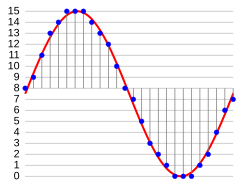
A content format is an encoded format for converting a specific type of data to displayable information. Content formats are used in recording and transmission to prepare data for observation or interpretation. [1] [2] This includes both analog and digitized content. Content formats may be recorded and read by either natural or manufactured tools and mechanisms.
In addition to converting data to information, a content format may include the encryption and/or scrambling of that information. [3] Multiple content formats may be contained within a single section of a storage medium (e.g. track, disk sector, computer file, document, page, column) or transmitted via a single channel (e.g. wire, carrier wave) of a transmission medium. With multimedia, multiple tracks containing multiple content formats are presented simultaneously. Content formats may either be recorded in secondary signal processing methods such as a software container format (e.g. digital audio, digital video) or recorded in the primary format (e.g. spectrogram, pictogram).
Observable data is often known as raw data, or raw content. [4] A primary raw content format may be directly observable (e.g. image, sound, motion, smell, sensation) or physical data which only requires hardware to display it, such as a phonographic needle and diaphragm or a projector lamp and magnifying glass.
The following are examples of some common content formats and content format categories (covering: sensory experience, model, and language used for encoding information):